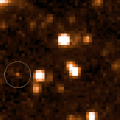File:PIA24578-NASA-TheAccident-InMotion-20210831.gif
Appearance
PIA24578-NASA-TheAccident-InMotion-20210831.gif (360 × 360 pixels, file size: 367 KB, MIME type: image/gif, looped, 28 frames, 2.0 s)
File history
Click on a date/time to view the file as it appeared at that time.
| Date/Time | Thumbnail | Dimensions | User | Comment | |
|---|---|---|---|---|---|
| current | 20:25, 1 September 2021 |  | 360 × 360 (367 KB) | Drbogdan | Uploaded a work by NASA/JPL-Caltech/Dan Caselden from https://photojournal.jpl.nasa.gov/archive/PIA24578.gif with UploadWizard |
File usage
The following page uses this file:
Global file usage
The following other wikis use this file:
- Usage on pl.wikipedia.org
- Wikipedysta:Sobi3ch/wikiportal:Astronomia2
- Portal:Astronomia/Szablony
- Portal:Astronomia
- Portal:Astronomia/Ciekawostki
- Wikipedysta:Wiklol/Astronomia - Ciekawostki
- Wikiprojekt:Czy wiesz/ekspozycje/2021-10-30
- WISE 1534-1043
- Wikiprojekt:Czy wiesz/archiwum/2021-10
- Dyskusja wikiprojektu:Czy wiesz/ekspozycje/2021-10-30



